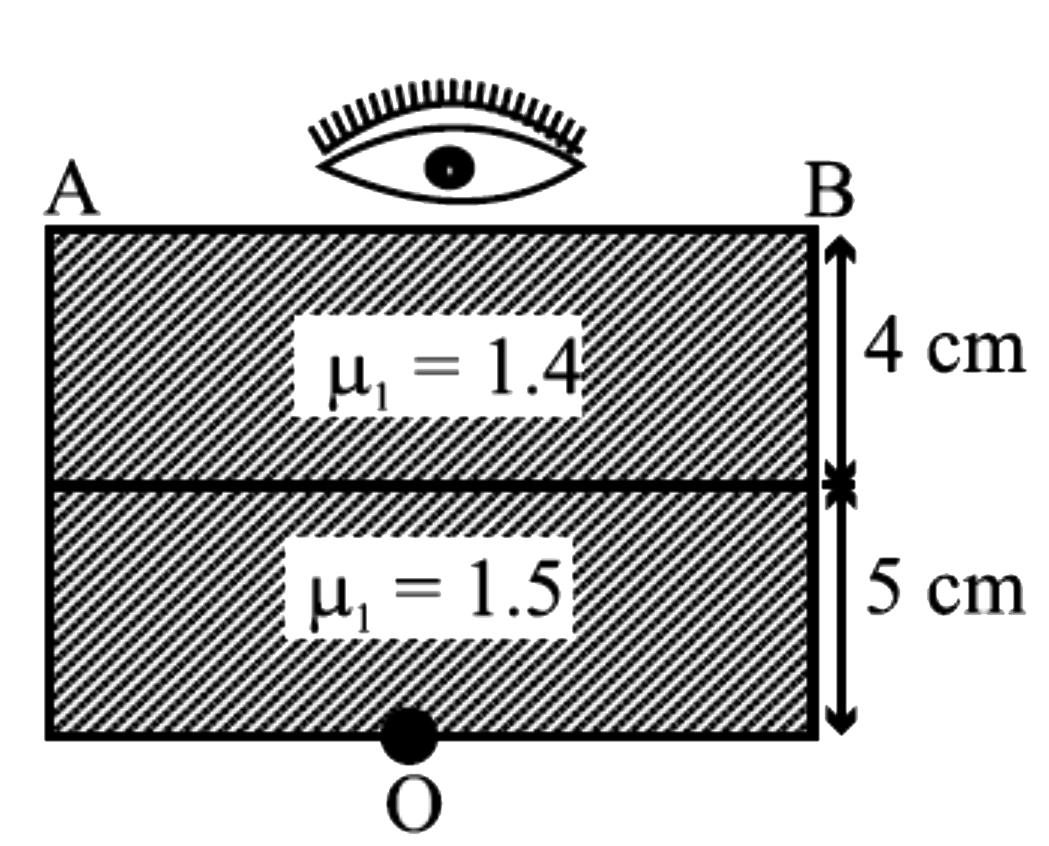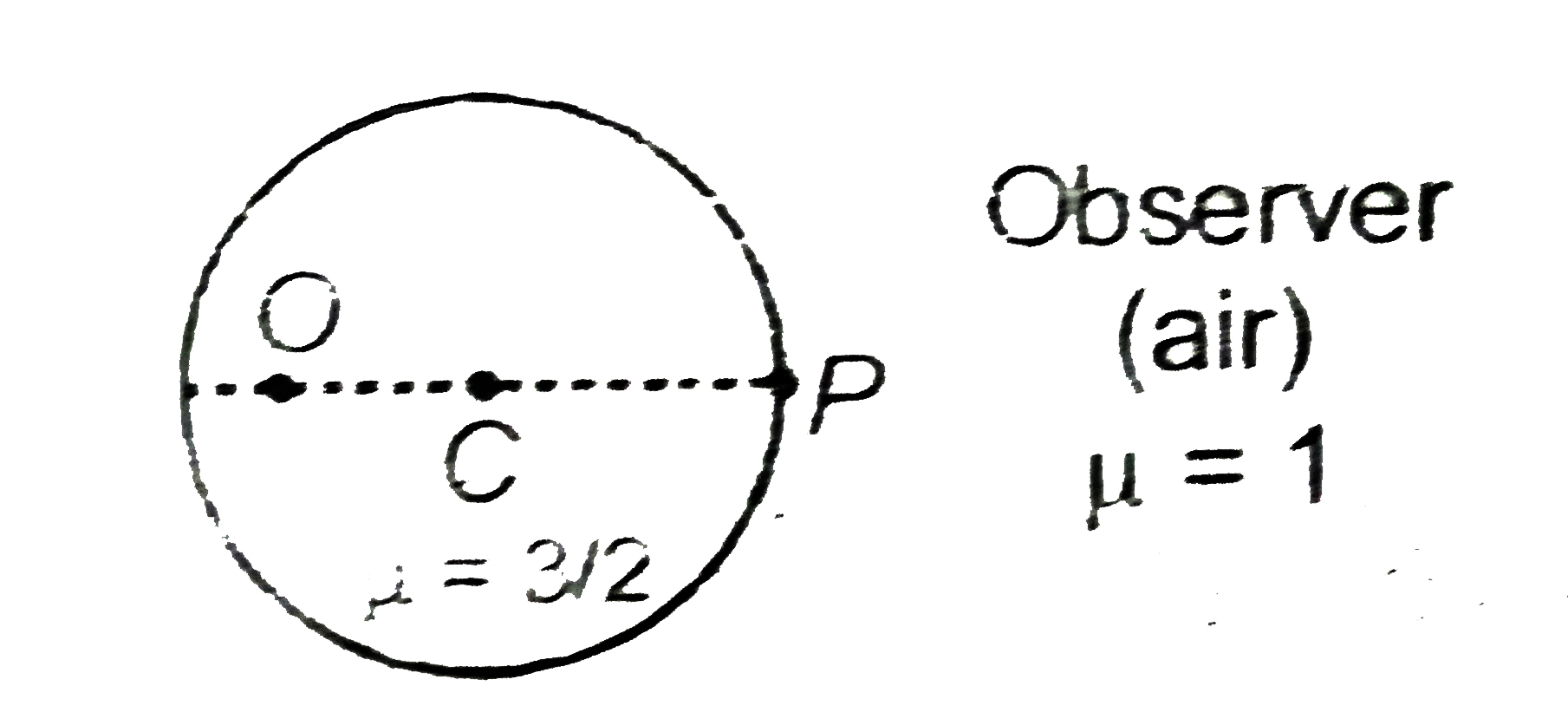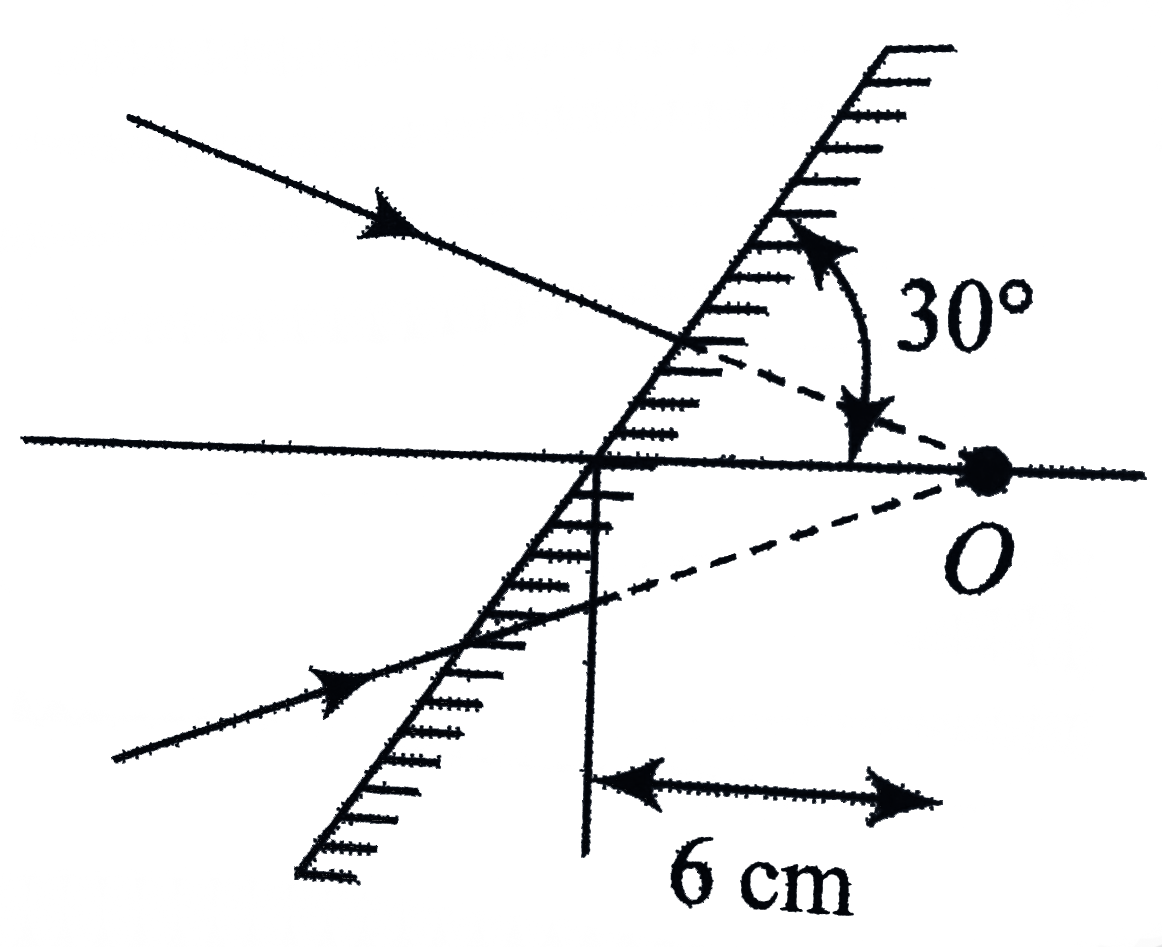There is a solid transparent sphere with a point object embedded at its centre. Apparent location of the point object will be
closer to eye than its actual location
farther away from eye than its actual location
same as its actual location
same for any material
The correct Answer is:C, D
To determine the apparent location of a point object embedded at the center of a solid transparent sphere, we can analyze the situation using the principles of optics. Here’s a step-by-step solution:
Step 1: Understand the setup
We have a solid transparent sphere with a point object located at its center. The radius of the sphere is denoted as R.
Hint: Visualize the sphere and the point object at its center to understand the light path.
Step 2: Analyze light rays
When light rays emanate from the point object at the center, they travel in all directions. However, since the object is at the center of a symmetric medium (the sphere), the light rays will behave uniformly.
Hint: Consider how light travels through a medium and how it behaves at the boundaries.
Step 3: Normal incidence
Any light ray that travels directly outward from the center will strike the surface of the sphere perpendicularly (normal incidence). At normal incidence, there is no refraction; the light continues in the same direction.
Hint: Recall the principle that light does not bend when it strikes a surface at a 90-degree angle.
Step 4: Apparent location of the object
Since the point object is at the center and light rays travel outward without deviation, the apparent position of the object, as viewed from outside the sphere, remains the same as its actual position.
Hint: Think about how the position of the object appears to an observer outside the sphere.
Step 5: Conclusion
The apparent location of the point object embedded at the center of the solid transparent sphere is the same as its actual position. This conclusion holds true regardless of the material of the sphere, as there is no refraction occurring at normal incidence.
Hint: Consider the implications of this conclusion for different materials and how it relates to the concept of optical density.
Final Answer
The apparent location of the point object will be the same as its actual position.
We have a solid transparent sphere with a point object located at its center. The radius of the sphere is denoted as R.
When light rays emanate from the point object at the center, they travel in all directions. However, since the object is at the center of a symmetric medium (the sphere), the light rays will behave uniformly.
Any light ray that travels directly outward from the center will strike the surface of the sphere perpendicularly (normal incidence). At normal incidence, there is no refraction; the light continues in the same direction.
Since the point object is at the center and light rays travel outward without deviation, the apparent position of the object, as viewed from outside the sphere, remains the same as its actual position.
The apparent location of the point object embedded at the center of the solid transparent sphere is the same as its actual position. This conclusion holds true regardless of the material of the sphere, as there is no refraction occurring at normal incidence.
The apparent location of the point object will be the same as its actual position.
Topper's Solved these Questions
- BOOK - MODERN PUBLICATIONCHAPTER - RAY OPTICS AND OPTICAL INSTRUMENTSEXERCISE - OBJECTIVE TYPE QUESTIONS (D. MULTIPLE CHOICE QUESTIONS)5videos
RAY OPTICS AND OPTICAL INSTRUMENTS
- BOOK - MODERN PUBLICATIONCHAPTER - RAY OPTICS AND OPTICAL INSTRUMENTSEXERCISE - OBJECTIVE TYPE QUESTIONS (ASSERTION REASON TYPE QUESTIONS)10videos
RAY OPTICS AND OPTICAL INSTRUMENTS
- BOOK - MODERN PUBLICATIONCHAPTER - RAY OPTICS AND OPTICAL INSTRUMENTSEXERCISE - OBJECTIVE TYPE QUESTIONS (JEE (ADVANCED) FOR IIT ENTRANCE)20videos
RAY OPTICS AND OPTICAL INSTRUMENTS
- BOOK - MODERN PUBLICATIONCHAPTER - NUCLEIEXERCISE - CHAPTER PRACTICE TEST FOR BOARD EXAMINATION15videos
NUCLEI
- BOOK - MODERN PUBLICATIONCHAPTER - SEMICONDUCTOR ELECTRONICS METERIALS DEVICES AND SIMPLE CIRCUITS EXERCISE - CHAPTER PRACTICE TEST FOR BOARD EXAMINATION12videos
SEMICONDUCTOR ELECTRONICS METERIALS DEVICES AND SIMPLE CIRCUITS
Similar Questions
Knowledge Check
- Question 1 - Select One
A solid transparent sphere has a small, opaque dot at its center. When observed from outside the apparent postion of the dot will be
ACloser to the eye than its actual positionBThe same as its actual positionCFarther away from the eye than its actual positionDIndependent of the refractive index of the sphere - Question 2 - Select One or More
A solid, transparent sphere has a small, opaque dot at its center. When observed from outside, the apparent position of the dot will be
ACloser to the eye than its actual positionBFarther away from the eye than its actual positionCThe same as its acutal positionDIndependent of the refractive index of the sphere - Question 3 - Select One
The apparent depth of an object O from AB is
 A4.29cmB5.43 cmC6.19 cmD5.99 cm
A4.29cmB5.43 cmC6.19 cmD5.99 cm
In a spherical paper weight (R = 10 cm) made of glass of refractive index μ=32, an object is embedded at a distance 5 cm from its centre. What is the apparent position of the object when seen from the opposite side (see figure)?
 View Solution
View SolutionWhen is a moving object considered as a point object ? Give some example.
View SolutionImage of an object kept on the principal axis of transparent sphere with silvered rear surface
A sphere of radius 1m and n=1.5 is silvered at its back. A point objet is kept at a distance of 1m from the front face (Fig. 34-30). Where will the final image be formed ?View SolutionConsider the object shown in the figure. It consist of a solid hemisphere of mass M and radius R. There is a solid rod welded at its centre. The object is placed on a flat surface so that the rod is vertical. Mass of the rod per unit length is M2R. What is the maximum length of the rod that can be welded so that the object can perform oscillations about the position shown in diagram?
Note : Centre of mass of a solid hemisphere is at a distance of 3R8 from its base.
 View Solution
View SolutionA real image of a point object is formed in a mirror when
View Solution


